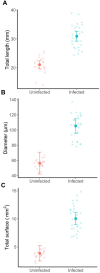Malpighamoeba infection compromises fluid secretion and P-glycoprotein detoxification in Malpighian tubules
- PMID: 32994425
- PMCID: PMC7525526
- DOI: 10.1038/s41598-020-72598-z
Malpighamoeba infection compromises fluid secretion and P-glycoprotein detoxification in Malpighian tubules
Abstract
Malpighian tubules, analogous to vertebrate nephrons, play a key role in insect osmoregulation and detoxification. Tubules can become infected with a protozoan, Malpighamoeba, which damages their epithelial cells, potentially compromising their function. Here we used a modified Ramsay assay to quantify the impact of Malpighamoeba infection on fluid secretion and P-glycoprotein-dependent detoxification by desert locust Malpighian tubules. Infected tubules have a greater surface area and a higher fluid secretion rate than uninfected tubules. Infection also impairs P-glycoprotein-dependent detoxification by reducing the net rhodamine extrusion per surface area. However, due to the increased surface area and fluid secretion rate, infected tubules have similar total net extrusion per tubule to uninfected tubules. Increased fluid secretion rate of infected tubules likely exposes locusts to greater water stress and increased energy costs. Coupled with reduced efficiency of P-glycoprotein detoxification per surface area, Malpighamoeba infection is likely to reduce insect survival in natural environments.
Conflict of interest statement
The authors declare no competing interests.
Figures






References
-
- Maddrell S, Gardiner B. Excretion of alkaloids by Malpighian tubules of insects. J. Exp. Biol. 1976;64:267–281. - PubMed
Publication types
MeSH terms
Substances
Grants and funding
LinkOut - more resources
Full Text Sources

